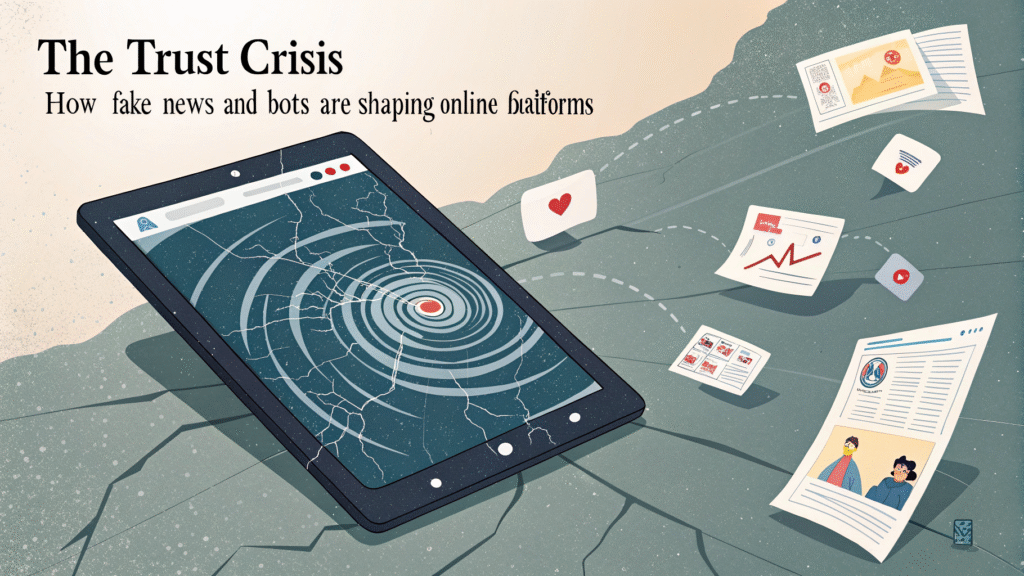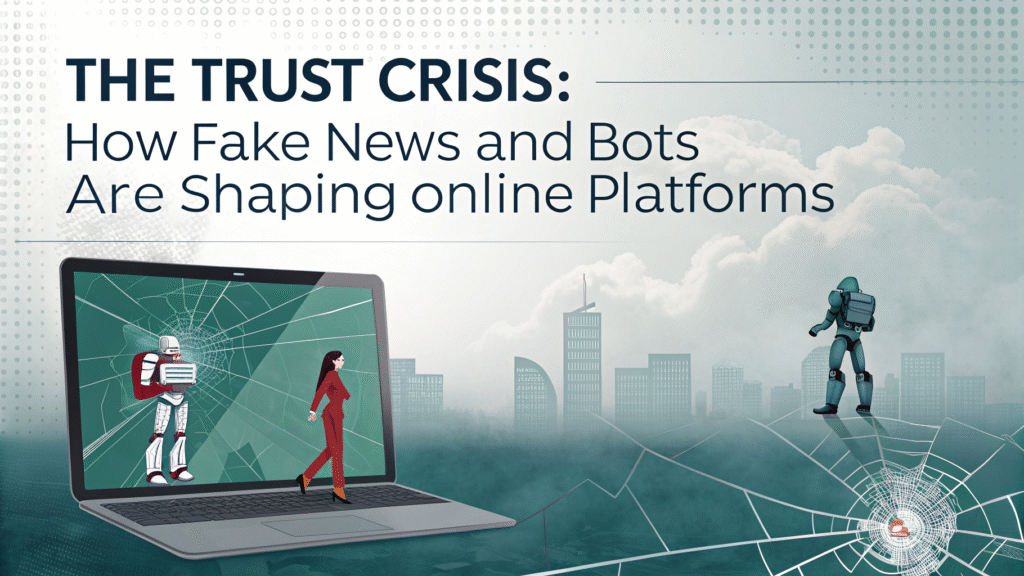
Introduction
Scroll, like, share, repeat. This daily ritual now happens against a backdrop of widespread skepticism. We are in the midst of a profound trust crisis, where the very foundations of our digital interactions are being eroded. The dual forces of sophisticated disinformation campaigns and armies of automated accounts are manipulating what we see and believe online. For entrepreneurs, marketers, and content creators, this isn’t just a social issue—it’s a core business challenge. When audiences can’t distinguish legitimate brands from malicious actors, every marketing dollar becomes less effective. This article explores fake news and social media trust, examining how bots and misinformation actively shape online platforms and providing a clear path for building credibility in an uncertain digital landscape.
History & Evolution: From Niche Threat to Mainstream Crisis
The trust crisis didn’t emerge overnight. It evolved alongside the platforms themselves, fueled by changing incentives and technologies.
- The Early Web (1990s – Early 2000s): While spam and hoaxes existed, the scale was limited. Online communities were often smaller and more niche, fostering a sense of shared responsibility and moderation.
- The Rise of Social Media (Mid-2000s): Platforms like Facebook and Twitter connected the world but also created a centralized environment where information could spread virally. The business model prioritized engagement, creating a fertile ground for sensationalism.
- The Weaponization of Information (2016 Era): Events like elections brought the issue to the forefront. It became clear that fake news and bots could be used to manipulate public opinion on a massive scale, marking a turning point in the trust crisis.
- The AI and Deepfake Era (Present Day): Today, artificial intelligence allows for the creation of highly convincing fake content, from computer-generated text to deepfake videos, making the problem more sophisticated and dangerous than ever before.
Alt text: A visual timeline showing the history of the trust crisis, highlighting the role of fake news and bots over time.
Audience & Demographics: Who is Affected?
The trust crisis impacts every user, but different groups experience it in unique ways.
- General Consumers: They face information overload and “truth decay,” leading to decision fatigue and anxiety. Many are retreating to private groups or becoming highly skeptical of all online sources.
- Businesses and Brands: Marketing messages are met with increased skepticism. Building a reputable brand requires more effort and transparency than ever before. Furthermore, brands can be harmed by false information spread by bots.
- Content Creators and Influencers: Authentic creators must work harder to prove their legitimacy. They are often competing against bots that artificially inflate follower counts and engagement, distorting the market.
- Journalists and Media Outlets: Their role as gatekeepers of information has been undermined, forcing them to focus heavily on fact-checking and transparent sourcing to rebuild credibility.
Key Features & Functions: The Mechanics of Manipulation
The architecture of modern online platforms often unintentionally facilitates the trust crisis.
The Bot Ecosystem
- Automated Amplification: Additionally, bots can quickly like, share, and comment on specific content, creating an artificial sense of popularity and momentum around a piece of fake news.
- Trend Manipulation: By coordinating activity, bot networks can hijack hashtags and push certain topics into trending feeds, giving fringe ideas a false appearance of mainstream support.
- Astroturfing: This tactic uses bots to create the illusion of widespread grassroots support for a product, politician, or idea, making it difficult for users to discern organic sentiment from manufactured consensus.
Algorithmic Vulnerabilities
- Engagement-Optimized Feeds: Furthermore, platform algorithms show users content that keeps them engaged. As a result, fake news often exploits highly engaging emotions like outrage, fear, and surprise.
- The Speed vs. Accuracy Dilemma: Moreover, the real-time nature of platforms rewards those who break news first, not those who verify it. Consequently, misinformation spreads widely before fact-checkers can debunk it.
Business & Marketing Potential: Building Trust as a Competitive Advantage
In a landscape defined by a trust crisis, authenticity becomes your greatest asset.
- Trust as a Brand Differentiator: In a sea of skepticism, a reputation for honesty and transparency can set your business apart and foster deep customer loyalty.
- The Value of Authentic Engagement: Prioritize genuine conversations with your audience over vanity metrics. A smaller, highly-engaged community that trusts you is more valuable than a large, disengaged follower count inflated by bots.
- Leveraging Social Proof Correctly: Focus on authentic user-generated content, verified reviews, and case studies. This real-world evidence is far more powerful than any branded message.
- Educational Content Builds Authority: Create content that genuinely helps your audience solve problems. By becoming a reliable source of information, you build authority and trust organically.
Best Practices & Tips for Navigating the Crisis
Here’s how your business can proactively combat the trust crisis and build a resilient online presence.
- Verify Before You Amplify: Always check the source of information before sharing it. Use fact-checking websites and look for corroboration from reputable news outlets.
- Be Transparent and Human: Show the people behind your brand. Use behind-the-scenes content, admit mistakes openly, and explain your business processes. Authenticity is a powerful antidote to distrust.
- Secure Your Own Digital Real Estate: Your website and email list are assets you control. Use social media to drive traffic to these owned channels, where you can communicate without algorithmic interference.
- Implement Clear Moderation Policies: For businesses with active online communities, clear rules and consistent moderation help create a safe, trustworthy environment.
- Educate Your Audience: Share tips on how to spot fake news and bots. This not only provides value but also positions your brand as a credible voice.
Challenges & Limitations
Addressing the trust crisis involves overcoming significant systemic hurdles.
- The Scale of the Problem: Billions of people upload content daily, making it impossible to manually review everything. Meanwhile, bad actors constantly adapt their tactics.
- Freedom of Speech Concerns: Platforms face difficult decisions in balancing the removal of harmful content with protecting free expression, often leading to inconsistent enforcement.
- Sophistication of AI: As AI tools for generating text, images, and video become more accessible, the volume and quality of deceptive content will increase dramatically.
- Monetary Incentives: There is still a financial incentive for creating viral fake news through ad revenue or driving traffic to malicious sites.
Future Outlook
The fight against the trust crisis will shape the next generation of online platforms.
- Advanced Verification Tools: Expect wider adoption of identity verification, blockchain-based content authentication, and AI-powered detection tools to label or filter dubious content.
- Shift to Decentralized Models: Decentralized social networks may give users more control over their feeds and moderation, potentially reducing the power of centralized algorithms.
- Increased Regulation: Governments will likely introduce stricter laws around political advertising, platform liability, and the labeling of AI-generated content.
- The Rise of “Trust Metrics”: We may see platforms develop and display new metrics focused on content credibility and source reliability, moving beyond mere engagement numbers.

Conclusion
The trust crisis, fueled by fake news and bots, is a defining challenge of the digital age. For businesses, it demands a fundamental shift in strategy—from chasing viral moments to building durable trust. By prioritizing transparency, authenticity, and value, you can rise above the noise. Navigating this crisis is not just about protecting your brand; it’s about seizing the opportunity to become a beacon of reliability for your audience. In the future, the most valuable currency online will not be likes or shares, but trust.